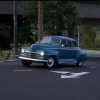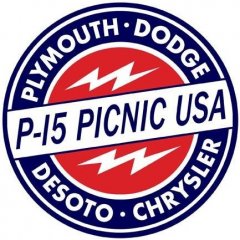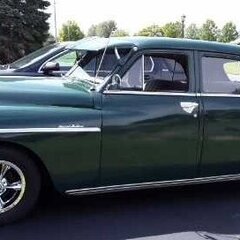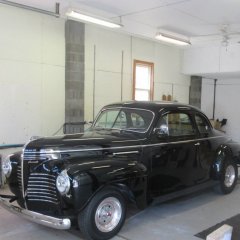-
Posts
1,927 -
Joined
-
Last visited
-
Days Won
23
James_Douglas last won the day on July 7 2024
James_Douglas had the most liked content!
Reputation
517 ExcellentContact Methods
-
Website URL
http://www.dacoglu.com
-
Biography
Long time classic car guy. I can be hounded directly at JDD (at) 8bells dot commercial.
-
Occupation
Technology
Profile Information
-
Location
San Francisco
-
My Project Cars
None
Converted
-
Location
San Francisco
-
Interests
Planes, Trains, and Automobiles
Recent Profile Visitors
The recent visitors block is disabled and is not being shown to other users.
-
It should be stamped on the pad. James
-
I may add that if the fluid gets low in an OD transmission it will burn up needle bearings in the planet gears in a heartbeat. Check the trans lube level every quarter if you drive it a lot. Know that there are ZERO rear replacements OD planet gears out there. One of these day, if I live long enough, I will look into re-machining the planet assembly to put new bearing into the gears and housing. James
-
I vaguely remember that some of them needed a fairly thick steel washer (gasket) under them to work properly. If it is missing sometimes it will not work.
-
What rear gearing are you using. My 1947 Desoto Suburban shifts at different speeds if I have the 3.91 gears or the 4.3 gears. James.
-
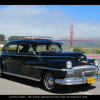
AB the only source for rear main oil seal?
James_Douglas replied to motoMark's topic in P15-D24 Forum
I have commented on this before, but I have had terrible luck with the Best Neoprene Seals. On my '47 with a NOS crankshaft that was balanced and polished I have had several of their seals leak. If you look in the archives I posted photos of the best seal and a NORS Victor seal. The differences are obvious. The Victor seal has a much larger contact area on the shaft then the Best version. Also they had a vulcanized fabric on the seal surface as well. I also contacted Best and asked for the Engineering specification as to the allowed shaft minimum size and maximum size for their seal. They would not provide one. I suspect that my crankshaft my be too big for their seal specification and as soon as it turns the mico-lip gets destroyed. But without specification to check what the shaft ID-OD tolerance is for the seal there is no way to know. Now I resurrected an engine some years ago that was rebuilt in 1964 by Automotive Engineering and then got parked in 1965 and did not fire off for decades. I cleaned the pan and ran the engine. The rear main is sealed very well, better than most. The seal is rope. I think that the Best Seal has too small a contact point on the crankshaft. If there is any undue stress back there (shaft movement) or any contaminates get in there that thin micro-lip get damaged in a split second and then never will seal right. Micro Lip modern seal are great on modern engines with their close tolerances, but on older cars I wonder. As an aside a lot of people who race old XKE's found out the hard way that modern seals just do not work on XKE inboard disc brake axle seals. The things get too hot and the seal die and oil dumps out. The old leather seals take the heat and have a larger contact area. Just like the pinion seals in our cars. I use NOS or NORS pinion seals if the leather is still good or modern leather if I can get them on my Desoto's. In the future all of my engines will get rope rear main seals, and on the blocks that have the bolt on back plate style neoprene seal, I may use both. James -
Actually there was an earlier 8-3/4 axle then the one we all know about in the later 1950's. It was used in the late 1930's to 1953 long wheelbase Chrysler and Desoto's as in the post war Town and Country. I have one in my Desoto Suburban and three sets of gears on the bench. All have 8-3/4 inch ring gears. James
-
I have been remiss on spending time on this forum this last year. Too much going on with our place out of town and as far as cars go, I have been working on the Dark Side....a V8 car. Since Sondra insisted on a car with AC now not in a couple of years, I went and picked up a 1964 Chrysler 300K. The old 1947 Desoto just needs to be taken off line after 22 years of daily driving. Of course the 300K needs work as well as it is a 94K mile original. After I get done with the Chrysler, I will go back to the Desoto and start on it. The 1949 Desoto Convertible is just fine. I need to drop the lower control arms and turn the inner pivot rods to get some more Caster but that is about it. I hope everyone is having a good 2023. Best, James
-
I have been otherwise occupied so I just now am reading this thread. Very nice work and good detail on what was done. My only comment, one I expressed in other threads some years back when looking into this is that the conversion using this rack may well be fine on the "lighter" cars, but not on the larger ones like my '47 Suburban. In fact, when I contacted Uni-Steer and also Flaming River they both said they do not make any racks for cars over 3500 pounds. There is a lesson in that. I always worried that a caviler rack in the 5000 to 6000 pound loaded Desoto Suburban on a trip at 70 MPH may fail if I hit a big pot hole. The Uni-Steer and also Flaming River folks on the phone when pressed said that their custom units gears, the actual rack teeth may not take a hit on the larger cars without a failure. They are just not designed for the weight. I suspect, but I do not know, that the same may be true with the caviler racks. The experience of racer-x is a warning shot on this. I am not saying it would fail, but on the larger sedans, station wagons and limos like a Suburban, I suspect that the loading may be close to a danger zone. Something to think about. James
-
Here is the SIA article in a PDF. Over the next six months I need to decide if I am going to rebuild the 1947 Suburban or sell it. The 1964 Chrysler 300K is taking over the daily driving duties as my wife insists on power steering and A/C and I really do not want to have to rework the '47 to get all that. I also am taking stock on space considerations. The other issue is that the '47 was going to be used for our cross country driving. But so many place now have car window smash and grabs that we just do not want to leave our Oshkosh Luggage in the '47 for all to see. I know what will happen. The trunk in the 300K is going to get 1/2 bolt solenoids so without the key fob you will never get it open. Out of sight and out of mind... James SIA_Article_Desoto_Suburban.pdf
-
The moderator can move this if they wish, but I would suggest that it be left here so everyone will see it.... To all Classic Car Hobbyists, particularly in California. I have had reports that the CARB has sent surveys to randomly selected people that were pulled from the Department of Motor Vehicles Data base. People who have classic cars. The survey reads to the trained eye as a foundational study to regulate classic cars and their use. The problem is that the survey methodology is so flawed as to make the results worthless in the real world. It can however be used by unscrupulous policy makers to back up ideas that they want to implement. The questions, abbreviated are as follows: In which county is your MY 1978 or older vehicle primarily operated? What is the current odometer reading (total mileage since the car was new) on your MY 1978 or older vehicle? Please specify, and use your best estimate if you are not sure: Approximately how many miles does your MY 1978 or older vehicle get driven in a year? Please specify: How often is your MY 1978 or older vehicle driven? How is your MY 1978 or older vehicle stored when not in use? When you store your MY 1978 or older vehicle for an extended period of time when it is not being used, what do you typically do with the fuel tank? Each question has a list of answers to choose from. The problem with this so-called survey is the methodology which is so bad is to be an insult to professional Transportation Survey Researchers. The survey is a random sample from the DMV database. Their assumption is that the survey respondents are a representative sample of all the classic car owners in the DMV database. In techno speak the small “n” represents the large “N”. In this case it does not. As classic car hobbyists all know, there are people who have collections of 5 cars, 10 cars, 100 cars. If someone with a collection responds to the survey on one car in a collection it is possible that the particular car, which was pulled at random for the survey, is this hobbyist’s daily driver classic car or it could be a concourse car that is never driven. Even if they pulled enough data to have a legitimate 95% - 90% confidence level, the lack of homogeneity of the hobby means that their conclusions will be junk. I suggest that every classic car hobbyist in California contact their elected representatives and ask why with a budget deficit looming in California that the CARB is being allowed to spend taxpayer money on junk science. Ask they investigate shutting this kind of junk science down. As an aside, in the 1990’s there was a push by CARB and some legislators to place restrictions on classic cars. They made, what at the time, were clearly false representations as to data they had backing up their wish list. When confronted with their nonexistent data they backed down. We should not allow them to create bad science data to do the same things now. Act! James Douglas San Francisco.
-
twhiteaz started following James_Douglas
-

Running lean....leaking vacuum advance??
James_Douglas replied to Sam Buchanan's topic in P15-D24 Forum
Make sure you double check the little step up piston in the BB Carb. Every year I do after it gummed up some years ago. The water vapor in the fuel causes an issue there. See my old posts on that. If it hangs up you can get a rich or lean condition. James -

Oil leak under chaincase cover on 48 DeSoto!
James_Douglas replied to MarcDeSoto's topic in P15-D24 Forum
I would by a new hub. Then take the old one to a machine shop and ask then to turn it down a few thousands and also to turn the inside a very little bit so it will slide nice onto the crankshaft without the key. Then use that hub as 'the tool" to center the cover. That is what I did. Works fine. James -
What a tempest I started by my suggestion. The bolt trick was given to me by a man that was originally and Aircraft A&P Mechanic who opened his own auto repair shop in about 1960. He is now about 87 Years old and still running his shop. The bolt trick is a good trick for a failure. I have in fact seen a couple of fluid Coupling Failures over the years. Most are seal failures but I have seen two bearing failures which causes the units to make the most god offal noise. Having a bolt in the glove box is a good thing if on the road and something goes wrong. It can get you to where you need to be. That said, unless one is living someplace real flat, I would not use the bolt for a long periods of time as the small clutch will not take it for too long. ***That said there was a taxi clutch that was available back in the day that was a little bigger and more robust for the fluid drive. But try finding one! I have 4 or 5 units. I also have the tools to change the seals and have found a couple of seals over the years. There are enough of them out there that if one goes bad, one can be had for next to nothing. Once can always send one to NW Trans for the conversion to a modern seal as well...for about $1500... One of these years I plan on rebuilding two of them and giving away the rest. James
-

New king pin a hair too big - what to do?
James_Douglas replied to motoMark's topic in P15-D24 Forum
In response... The tapered pin that wedges in to hold the king pin makes it so that the king pin does not rock in the hole. When I say a nice fit that drops in I mean JUST slides in without any side movement. Torington needle bearings have the same strength as a bronze bushings AND they are less susceptible to cold flow under heavy loading. The top bushing or bearing is under tremendous side thrust pressure. The bearings are much better than the bushing are resisting the side thrust. James -

New king pin a hair too big - what to do?
James_Douglas replied to motoMark's topic in P15-D24 Forum
For 0.005, just take a brake cylinder ball home and run it in the upright hole until you get the pin to slide in nice. One thing I will mention is for folks to go read my posts on using torrington needle bearings as apposed to bushings. I think that any of the old cars with manual steering that I can get a needle bearing into the upper I would do it. It just turns better. James


